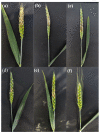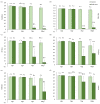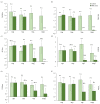Fusarium Head Blight Infection Induced Responses of Six Winter Wheat Varieties in Ascorbate-Glutathione Pathway, Photosynthetic Efficiency and Stress Hormones
- PMID: 37960076
- PMCID: PMC10649800
- DOI: 10.3390/plants12213720
Fusarium Head Blight Infection Induced Responses of Six Winter Wheat Varieties in Ascorbate-Glutathione Pathway, Photosynthetic Efficiency and Stress Hormones
Abstract
Fusarium head blight (FHB) is one of the most studied fungal diseases of wheat, causing massive grain yield and quality losses. This study aimed to extend previous studies on the physiological and biochemical responses of winter wheat to FHB stress in a controlled environment by focusing on the ascorbate-glutathione pathway (AsA-GSH), photosynthetic efficiency, and stress hormone levels, thus providing insight into the possible interactions of different defense mechanisms during infection. The activity of AsA-GSH metabolism was increased in FHB resistant varieties, maintaining the redox state of spikes, and consequently preserving functional photosystem II. Furthermore, carotenoids (Car) were shown to be the major pigments in the photosystem assembly, as they decreased in FHB-stressed spikes of resistant and moderately resistant varieties, compared to controls. Car are also the substrate for the synthesis of abscisic acid (ABA), which acts as a fungal effector and its elevated content leads to increased FHB susceptibility in inoculated spikes. The results of this study contributed to the knowledge of FHB resistance mechanisms and can be used to improve the breeding of FHB resistant varieties, which is considered to be the most effective control measure.
Keywords: AsA-GSH cycle; FHB; abscisic acid; photosynthetic efficiency; salicylic acid; wheat.
Conflict of interest statement
The authors declare no conflict of interest.
Figures








Similar articles
-
Changes in Antioxidant System during Grain Development of Wheat (Triticum aestivum L.) and Relationship with Protein Composition under FHB Stress.Pathogens. 2019 Dec 23;9(1):17. doi: 10.3390/pathogens9010017. Pathogens. 2019. PMID: 31878029 Free PMC article.
-
Early response of wheat antioxidant system with special reference to Fusarium head blight stress.Plant Physiol Biochem. 2017 Jun;115:34-43. doi: 10.1016/j.plaphy.2017.03.010. Epub 2017 Mar 14. Plant Physiol Biochem. 2017. PMID: 28319793
-
Metabolic Profiling Identifies Changes in the Winter Wheat Grains Following Fusarium Treatment at Two Locations in Croatia.Plants (Basel). 2023 Feb 17;12(4):911. doi: 10.3390/plants12040911. Plants (Basel). 2023. PMID: 36840259 Free PMC article.
-
Fusarium Head Blight in Durum Wheat: Recent Status, Breeding Directions, and Future Research Prospects.Phytopathology. 2019 Oct;109(10):1664-1675. doi: 10.1094/PHYTO-03-19-0095-RVW. Epub 2019 Sep 3. Phytopathology. 2019. PMID: 31369363 Review.
-
Fusarium Head Blight and Rust Diseases in Soft Red Winter Wheat in the Southeast United States: State of the Art, Challenges and Future Perspective for Breeding.Front Plant Sci. 2020 Jul 16;11:1080. doi: 10.3389/fpls.2020.01080. eCollection 2020. Front Plant Sci. 2020. PMID: 32765563 Free PMC article. Review.
Cited by
-
Molecular Investigations to Improve Fusarium Head Blight Resistance in Wheat: An Update Focusing on Multi-Omics Approaches.Plants (Basel). 2024 Aug 6;13(16):2179. doi: 10.3390/plants13162179. Plants (Basel). 2024. PMID: 39204615 Free PMC article. Review.
-
Sugar and Free Amino Acid Contents in Winter Wheat Flour Under Fusarium Head Blight Treatment and Natural Infection.Plants (Basel). 2025 May 16;14(10):1504. doi: 10.3390/plants14101504. Plants (Basel). 2025. PMID: 40431069 Free PMC article.
-
Sustainable antifungal potential of ZnO and MoS2 nanoparticles against Fusarium oxysporum and Fusarium graminearum.World J Microbiol Biotechnol. 2025 Aug 14;41(8):312. doi: 10.1007/s11274-025-04531-3. World J Microbiol Biotechnol. 2025. PMID: 40804182
References
-
- Serfling A., Kopahnke D., Habekuss A., Novakazi F., Ordon F. Wheat Diseases: An Overview. In: Langridge P., editor. Achieving Sustainable Cultivation of Wheat. Volume 1. Burleigh Dodds Science Publishing; Cambridge, UK: 2017. pp. 263–294. Burleigh Dodds Series in Agricultural Science. - DOI
-
- Różewicz M., Wyzińska M., Grabiński J. The Most Important Fungal Diseases of Cereals—Problems and Possible Solutions. Agronomy. 2021;11:714. doi: 10.3390/agronomy11040714. - DOI
-
- Buerstmayr M., Steiner B., Buerstmayr H. Breeding for Fusarium Head Blight Resistance in Wheat—Progress and Challenges. Plant Breed. 2020;139:429–454. doi: 10.1111/pbr.12797. - DOI
Grants and funding
LinkOut - more resources
Full Text Sources

